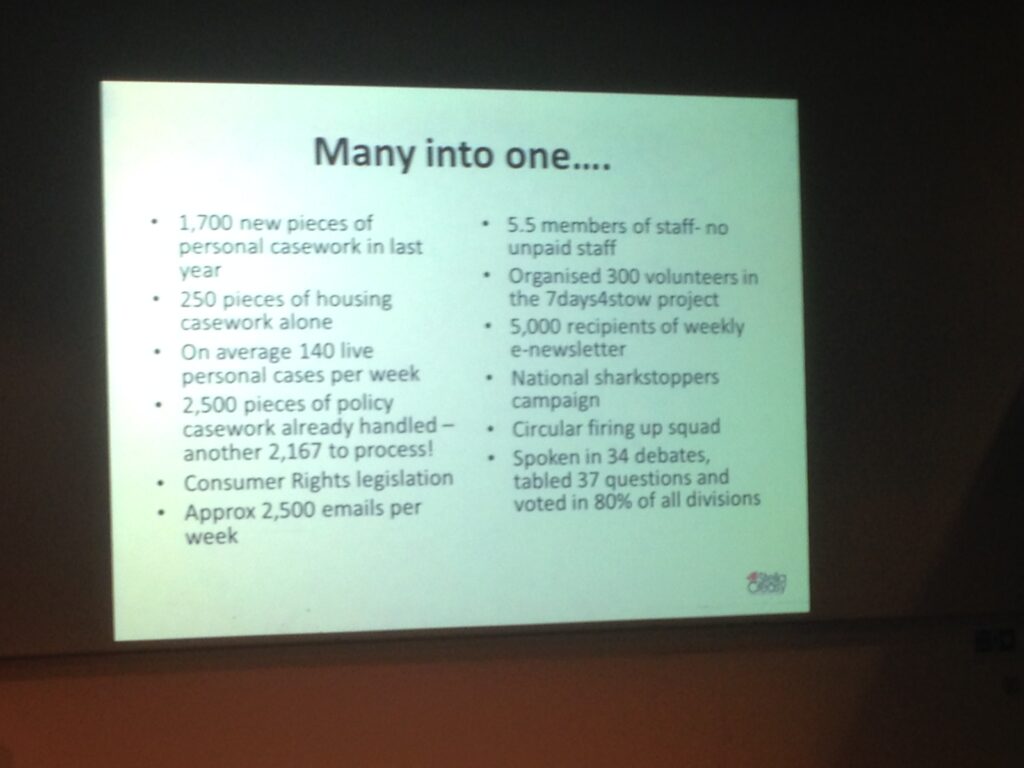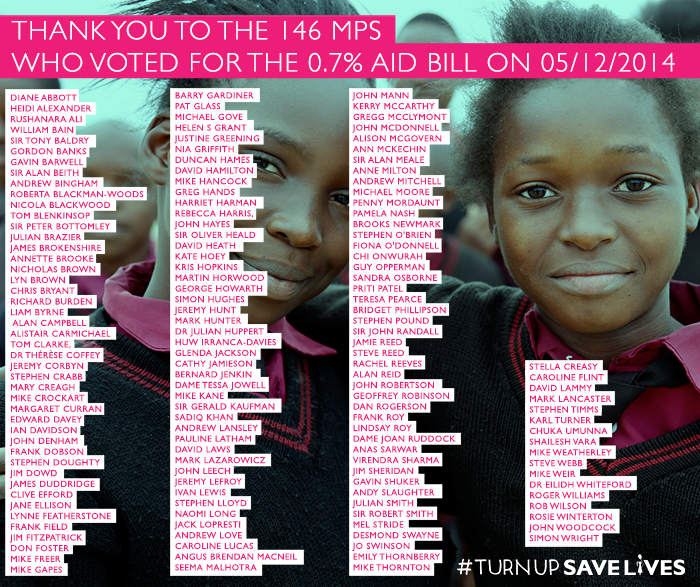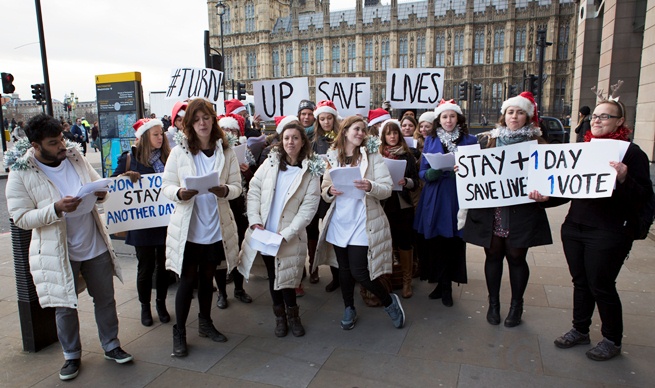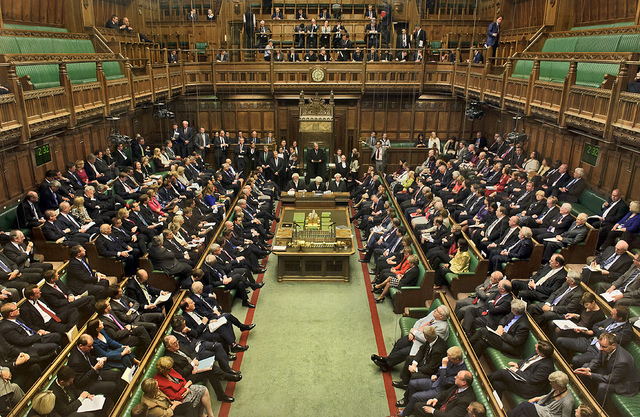It’s a truth, almost universally acknowledged, that MPs don’t like ‘email your MP’ petitions.Listen to MPs talk to campaigners, and they’ll tell you they find the annoying and a burden on precious staff time, but they’re a staple in most campaigning toolkits.
Most MPs will tell you that the volume of emails means it can be hard to distinguished between the signal and the noise? Don’t believe that? While this image is a little out of date (it’s from ECF2014) it was Stella Creasy sharing what, on average, comes into her inbox during a week in Parliament;

Now, I’m not suggesting that we should head calls from some MPs to stop petitioning them – they’re our elected officials so we should petition them. I’m also realistic that any ‘cross Parliament’ solution is unlikely to be adopted – MPs they say, have to be seen as 650 small businesses, so rarely do they all-adopt the same technology, unless they’re told to.
Plus I’m not going to dive into a debate about the quality of some campaigns, except to add that some email to MP campaigns don’t appear to have thought about what the theory of change is – and that has an impact all of us (all campaigners should read this on what makes an effective petition).
So what could replace them in our toolkit? Or if not replace improve how we use them?
1. Phone calls – Unlike the United States we don’t have much of a culture of calling your elected official – perhaps it’ll catch on? Even then it will still be likely to frustrate MPs as much as emails do as they don’t have the staff capacity to deal with the calls, or effective mechanisms to collect the information from them.
2. Parliament petition site – I’ve suggested before that the frustration of MPs could be channelled towards suggesting that they’ll only accept petitions via the official Parliament petition site. While the site has been improved, it still has lots of limitations – not least when it comes to supporter data which is held just by Parliament, that it’s a closed site (so it can’t be embedded on another website) and doesn’t allow for any personalisation by the signer.
3. Focus on a specific MP rather than all MPs – At the NCVO Campaigning Conference, Jess Phillips MP suggested that one of the most effective petitions she’d seen during her time in Parliament had been the change.org petition on the Tampon Tax, which had worked directly with Paula Sherriff MP to help to provide her with the evidence of support for the issue. Strikes me that most issues can find a Parliamentary champion or two, so perhaps this is a way forward?
4. Require your own message – MPs complain that too many emails are identikit, but while many of us try to persuade supporters to personalise the messages they send, have we tested what the drop off would be if we required supporters to come up with their own subject lines, or add in a reason why your signing? It wouldn’t solve the volume question, but could mean that MPs couldn’t accuse of us of just sending ‘identikit’ messages.
5. Better integration with casework software – many MPs who have large amounts of casework use software to track the requests that are coming in from constituents. How many of us are looking to see how we can incorporate our actions and messages into these?
6. Email to letter – Given I have an app on my phone that can turn my photos into a personalised postcard that can be sent in the post to a friend, could the same technology be developed to turn my email to an MP into a letter. It’d place a cost on the organisation behind the campaign, but it’d present the opportunity for delivery via another channel.
7. Snapchat – I can’t pretend to understand Snapchat – which probably means most MPs won’t either) but opportunities do new communication channels like Snapchat or WhatsApp provide new ways to communicate with MPs?
8. Bots – Florian from MoreOnion wonders here if the rise in the use of AI means that we’ll be able to design bots that will be able to automatically capture and engage in a campaign action – could that help MPs respond to our requests.
I’m sure other solutions exist , as well as examples of where petitions are having an impact – in the same presentations that I took that image from Stella Creasy talked about the importance of ensuring a petition is part of wider advocacy strategy – she specifically mentioned Friends of the Earth Bee campaign.
Either way what strikes me from the list above is that organisations have to be prepared to adapt and change rather than just defaulting to ’email your MP’. I look forward to hearing thoughts from others of how we make this tool work to have the maximum impact.
Tag: parliament
11 lessons from #TurnUpSaveLives
Yesterday, I was able to celebrate (with loads of others) a huge campaign victory.
Over the last few months, one of the campaigns that has kept me busy has been #TurnUpSaveLives, a push to enshrine in law our commitment as a country to spend 0.7% of our national income on international development.
It’s been hard work (with lots of spreadsheets), but I’ve been fortunate to work alongside a great team of colleagues from 20+ organisations.
The bill, which was brought to Parliament by a Private Members Bill from Lib Dem MP Michael Moore, has now passed through the House of Lords and should receive Royal Assent before the election. It’s a big win.
I’ve learnt a lot from the campaign, here are a few brief thoughts;
1. A week really is a long time in politics – Days before both the second and third reading, we were still short of the 100 MPs we need to commit to attend, as campaigners it felt like we were running out of time but turns out the MPs are used to making changes to the diaries at the last minute, so a week really is a long time in politics!
2. Movements take time to build – I really enjoyed reading this reflection from Steve Lewis from Results UK, a reminder that the ‘movement’ calling for 0.7% goes back over 30 years, and Steve’s personal memories of a lobby of Parliament in 1984 calling for 0.7%. The votes were the culmination of the campaigning that started over 30 years ago and had grown, often working on other related topics (debt, trade, tax) but coming back when needed to 0.7%.
3. Make sure you know the process – Private Members Bills (PMBs) aren’t like normal bills that are driven by the Government, so understanding the Parliamentary procedure was vital, for example PMBs require you to get at least 100 MPs to attend on a Friday (when most MPs are scheduled to be in their constituencies), have to pass a Money Resolution (where Parliament has to agree to spending money on what’s being proposed), and the outcome of the Second Reading is used to decide the composition of the Bill Committee.
It was vital to use supportive MPs to help us understand what to expect to make sure we didn’t miss an opportunity, as well as making use of the helpful Parliament website where you can track the progress of the Bill.

4. Opportunity Cost – For MPs to be in Parliament on a Friday, especially close to the election meant not attending a community event or meeting potential voters. We had to find ways to reduce the opportunity cost for MPs not being in their constituencies, for example we had a Lifesavers gallery where we publicly acknowledged (and thanked via twitter) who was attending, organised a photo moment with a celebrity to help MPs secure local media coverage, and placed a big emphasis on constituents writing or visiting MPs to ask them to attend.
5. Using Twitter – We got #turnupsavelives trending twice on the day of the Third Reading in December, it was thrilling, but looking through the tweets it proved that twitter can be a bit of an echo chamber, with most coming from those who were involved or supportive of the campaign.
However, where we did find twitter useful in the run up to to thank those MPs who had committed to attend or ask those who hadn’t to do so, as well as thanking those that did attend. Encouraging organisations to use their corporate accounts and also those of CEOs or other senior staff worked well, turns out MPs like to be thanked by NGOs. Having access to an in-house designer at Global Poverty Project to quickly turn around images we could share was invaluable.
6. Precedent – Often we’re campaigning were about looking to change somethings, but setting a precedent is one of the most overwhelming reasons not to do something for a politician. We found that early on in the campaign our hope to get parties to whip their MPs into attending was unlikely to happen, Labour doesn’t whip on Private Member’s Bill and didn’t want to set a precedent by doing so for this bill. So finding examples of where a party has done this before is really useful in demonstrating that you’re not asking to set a precedent in supporting your ask.
7 – Don’t forget to say thank you – I remember a MP once complaining to me that after he’d voted for something a campaigning organisation had asked him for the next letter he got was asking for something else. Its easy to forget to say ‘Thank You’ for MPs for voting (and we didn’t do enough after the second reading in September) but come the Third Reading, having a graphic ready to share the names of MPs who’d turned, sending cards from supporters, getting on the phone to key MPs, and writing letters from CEOs ensured we were doing all we could to show our appreciation to MPs who attended the vote.

8. Insider/Outside – The campaign was a great example of how insider and outsider tactics can work together. We needed to be mobilising constituents to email, tweet, call and visit MPs asking them to visit, that helped to create a belief that and a constituency of support, but we also needed to be working the corridors of Westminster, understanding the positions of the different parties, providing the arguments about why we need, getting CEOs to call key MPs to use their influence to make sure we reached enough MPs pledged to attend, etc.
9. Building the right coalition – We didn’t spend lots of agreeing how the coalition was going to work, instead we kept our structures lean and simple forming three groups (one for campaigners, media and public affairs colleagues) with central coordination from Bond. The Turn Up Save Live. We worked to ensure that we tried to get as many organisations involved, including Unions and Faith Leaders. On reflection, we could have done even more to build a unusual coalition in support.
10. Supporters loved it – Lots of organisations reported that the actions they’d invited supporters to take was one of the most popular actions, I think everyone enjoyed the binary nature of the campaign, that your MP was either going to turn up or not, rather than the indirect actions we’re often asking supporters to take appealed to people.
11. Working with Lords is completely different – That’s for another post, but we learnt quickly that the same approach wasn’t going to work. Lords need to be engaged in very different ways.
Want to learn more? I’d be delighted to come and speak to your team based on the learning from the campaign.
How are new MPs adjusting to campaign tactics?
Parliament rose for the summer recess this week, and it’s been interesting to see how the new (and some returning MPs) have responded to all the campaigning actions that they’ve been on the receiving end of.
Exhibit A is an Early Day Motion (EDM) from the new Conservative MP for Weaver Vale, Graham Evans, who ironically used an EDM to criticise the effectiveness of them. Evan’s argues that;
this House regrets the continuing decline in importance of Early Day Motions which have become a campaign tool for external organisations; notes the role of public affairs professionals in drafting Early Day Motions and encouraging members of the organisations they represent to send pro forma emails and postcards to hon. Members; further notes the huge volume of correspondence that this generates and the consequent office and postage costs incurred; believes that the organisations involved derive little benefit from Early Day Motions, which very rarely have any influence on policy;
Only 22 MPs signed onto it although many of them are from the new intake of Conservative MPs, which might signal a disinterest in using them as a tool to register their support for an issue in the future.
Many campaigners have long discussed the effectiveness of EDMs, described by some MPs, who refuse to sign onto them viewing them as a form of ‘parliamentary graffiti’, but others see them as a useful way of demonstrating support for an issue, and a way of giving MPs a specific action to take to demonstrate support for an issue. ConservativeHome has more on the EDM and a counter one from another Conservative MP, plus an interesting case study of how an EDM started a campaign to keep the General Election Night Special, although this came as a result of a campaign that was initiated and of particular interest to MPs.
Exhbit B is this recent report in Third Sector magazine from a Media Trust event at which Charles Walker MP, a backbench Conservative MP commented that ‘Charities often write to MPs asking us to write to ministers to express their disquiet. They assume their concerns must be our concerns. That’s almost bullying, to be honest. Lots of the lobbying MPs are subjected to is blunt and cackhanded’
Going on to say that some charities, such as Macmillan Cancer Support and a local hospice charity in his constituency, were very good at communicating with him. Inviting him to events they are holding locally and saying “It’s almost impossible for an MP to turn down an invitation from a charity that is doing good work in his or her constituency.”
It’s too early to tell if the new batch of MPs are going to be more or less receptive to popular campaigning, but these two examples should perhaps challenge campaigning organisatons to think afresh about the tactics and approaches that are going to use to influence the new (and old) intake.

